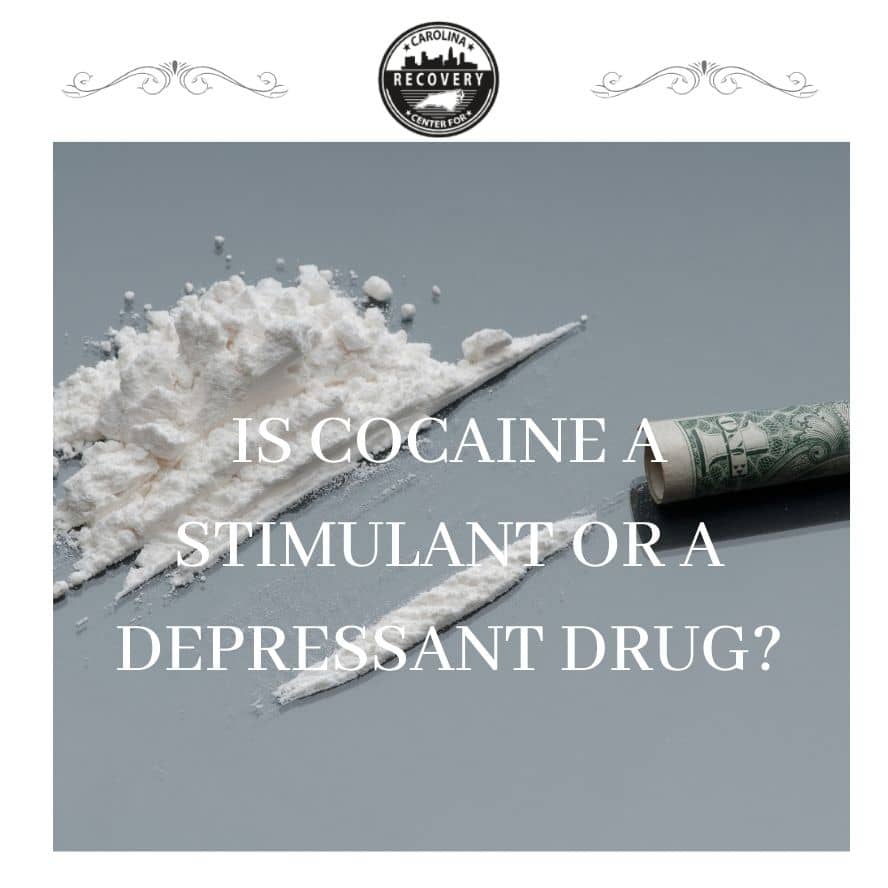Is Cocaine a Stimulant or a Depressant Drug?

Medically Verified: 2/1/24
Medical Reviewer
Chief Editor

All of the information on this page has been reviewed and verified by a certified addiction professional.
Different types of drugs produce different effects on the mind and body. Most drugs fall into one of three categories: stimulants, depressants, and hallucinogens. But what about cocaine? Is cocaine a stimulant or depressant drug?
Stimulant Drugs
Stimulants, also known as uppers, are drugs that increase energy and wakefulness by increasing activity in the central nervous system. Examples of commonly abused stimulants include:
- Adderall
- Amphetamine
- Caffeine
- Cocaine
- Methamphetamine
- Nicotine
Cocaine is primarily classified as a stimulant due to its ability to increase energy levels, enhance focus, and induce a sense of euphoria.
Depressant Drugs
Depressants, also known as downers, produce the opposite effects of stimulants by slowing down activity in the central nervous system. Depressant drugs produce relaxation, calmness, and sleepiness. Commonly abused depressant drugs include:
- Alcohol
- Barbiturates
- Benzodiazepines
- Cannabis (marijuana)
- Heroin
- Opioids
Cocaine does not slow down activity in the central nervous system nor does it produce the same side effects as depressant drugs, so it is not labeled as such. However, when the effects of cocaine wear off users often experience a “crash.” The crash period can make people feel depressed, tired, sleepy, and moody.
Hallucinogens
Hallucinogens are psychoactive drugs that produce altered states of consciousness and visual, tactile, and auditory hallucinations. Examples of hallucinogens include:
- Psilocybin (magic mushrooms)
- Lysergic acid diethylamide (LSD or Acid)
- Mescaline (Peyote)
- Ayahuasca (Dimethyltryptamine or DMT)
What is Cocaine?
Cocaine is a powerful and addictive stimulant drug that comes in the form of a fine white powder. It is usually snorted, but may also be injected, smoked, or synthesized into crack cocaine.
Cocaine is synthesized from the leaves of the coca plant, which is native to South America. It is a Schedule II controlled substance in the United States, indicating a high potential for abuse and dependence, but also accepted for limited medical use. Cocaine may be used sparingly in medical settings as local anesthesia for some surgeries.
The majority of cocaine use in the United States is illicit recreational use. As a street drug, cocaine is often mixed with additives like cornstarch, talcum powder, or flour. It can also be mixed with fentanyl, a powerful opioid that can lead to overdose.
While the most popular way to use cocaine is to snort it, some people process cocaine into rock-like crystals known as crack cocaine or freebase cocaine. Crack cocaine is typically snorted or injected, but it has the same effects as regular cocaine.
In 2021, about 4.8 million people used cocaine and about 1.4 million were addicted to it. In the same year, approximately 24,486 people died as a result of an overdose that involved cocaine.
Cocaine’s Effects on the Mind and Body
Cocaine is classified as a stimulant drug because of its effects on the mind and body.
When consumed, cocaine stimulates the central nervous system by increasing the levels of dopamine, norepinephrine, and serotonin in the brain. These neurotransmitters are responsible for regulating mood, reward, and motivation, leading to the desired stimulant effects.
When you take cocaine repeatedly, the reward circuit part of the brain will begin to adapt to the flood of dopamine, resulting in reinforced drug-taking behaviors. This reinforcement causes people to binge on cocaine to stay high, increase their dose to experience the desired effects, and develop a physical dependence on the drug.
The effects of cocaine appear almost instantly after ingestion and can last for 15-30 minutes. Short-term effects of cocaine include:
- Increased happiness
- Heightened energy
- Dilated pupils
- Euphoria
- Increased heart rate and blood pressure
- Increased body temperature
- Mental alertness
- Hypersensitivity to sight, sound, and touch
- Irritability
- Agitation
- Aggression
- Paranoia
- Increased wakefulness
- Insomnia
- Mood swings
- Tremors
- Muscle twitches
Prolonged cocaine use can harm the mind and body. Potential long-term side effects of cocaine abuse include:
- Loss of smell
- Nosebleeds
- Runny nose
- Problems swallowing
- Cough
- Asthma
- Respiratory problems
- Infections such as pneumonia
- Infectious diseases such as HIV or Hepatitis C
- Insomnia
- Mouth ulcers
- Perforated septum
- Depression
- Anxiety
- Weight loss
- Malnutrition
- Increased risk of seizure and stroke
- Psychosis
- Paranoia
- Dependence and withdrawal
- Addiction
- Social consequences
Signs of Cocaine Abuse and Addiction
Understanding that cocaine is a stimulant that increases activity in the central nervous system can help you identify when a loved one is abusing or addicted to cocaine. However, there are other signs of cocaine addiction to be aware of besides the immediate effects of the drug.
Common symptoms of cocaine addiction include:
- Neglecting Responsibilities – A person addicted to cocaine may start neglecting their responsibilities at work, school, or home. They may frequently miss deadlines, skip important engagements, or show a decline in performance.
- Social and Relationship Problems – Cocaine addiction often leads to strained relationships with family, friends, and romantic partners. The person may isolate themselves from loved ones or engage in manipulative behaviors to maintain their drug use.
- Financial Difficulties – Supporting a cocaine addiction can be financially demanding. Individuals may experience financial strain, borrow money frequently, or resort to illegal activities to obtain funds for buying cocaine.
- Risk-Taking Behaviors – Cocaine addiction can lead to impulsive and risky behaviors. This might include driving under the influence, engaging in unsafe sexual practices, or participating in illegal activities to acquire drugs.
- Changes in Physical Appearance – Excessive cocaine use can lead to noticeable physical changes. Some signs include weight loss, dilated pupils, and frequent nosebleeds.
Find Help for Cocaine Abuse and Addiction
At Carolina Center for Recovery, we believe in a comprehensive and holistic approach to treating addiction. Our clients receive individually tailored treatment services based on their needs, setting them up for success in recovery.
If you or someone you love are struggling with cocaine addiction, please contact us today to learn about your treatment options.
References:

